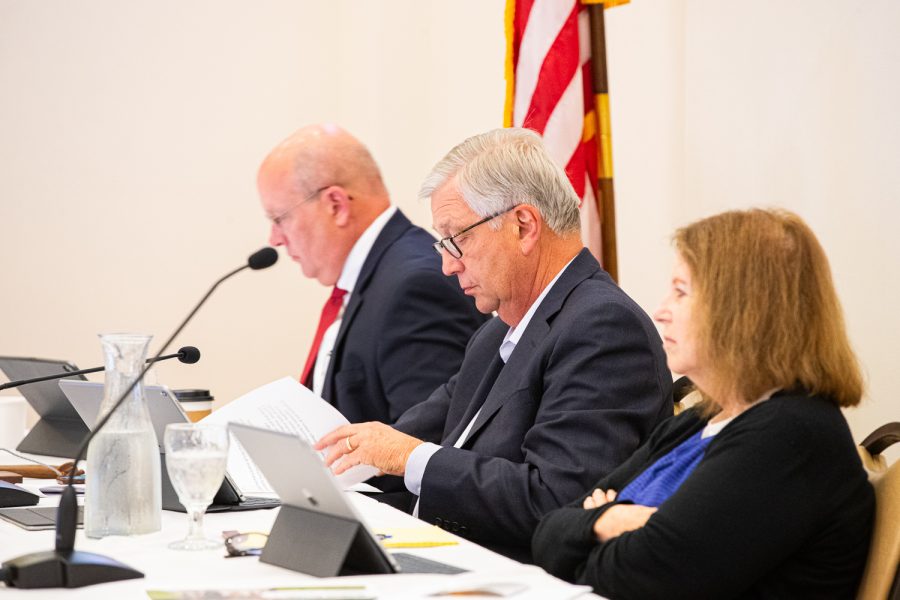State Board of Regents vote to increase tuition by almost 4 percent for University of Iowa
The state Board of Regents voted on June 6 to increase tuition at the University of Iowa and Iowa State University by 3.9 percent for academic year 2019-2020.
Iowa Board of Regents President Michael Richards sits alongside President Pro Tem Patty Cownie during a meeting at the Iowa State Alumni Center in Ames, Iowa, on Thursday, June 6, 2019. The Regents voted in favor of a four percent tuition increase starting in the fall semester of 2019.
June 6, 2019
AMES– After discussing tuition for the 2019-2020 academic for the final time, the state Board of Regents voted to increase tuition for resident students at the University of Iowa and Iowa State University by 3.9 percent after state allocations fell short of the $18 million requested.
Prior to the first tuition reading, the regents announced in April that resident undergraduate students at the UI and ISU could see the 3.9 percent increase and non resident undergraduates at the UI could see a 1 percent increase.
In the past, the regents would first read tuition in fall and then take a final vote in December. The timeline was then changed to have the first reading in April and final vote take place in June to allow for the state Legislature to determine state appropriations, without the regents resetting tuition after the final vote.
Even with a final tuition vote while classes aren’t in session, Regent President Mike Richards said he believes students will know what to expect when paying tuition in the fall. With the first reading of tuition in May, students still have time to plan for the increases, he said.
RELATED: Iowa regent universities to evenly split $12 million increase in state support
“The tuition rate is always going to be that rate or lower, so that it’ll be the same. I think that we communicated enough to the people so that I’m comfortable with the way we handled it,” Richards said.
Resident graduate and professional students can expect a 3 percent tuition increase, and non resident graduate students can expect a 1 percent increase to tuition in the next academic year.
There is currently no tuition model outlining increases for graduate and professional students as there is for undergraduate students. At the first tuition reading, UI Graduate and Professional Student Government President Dexter Golinghorst asked that the regents create the same transparency and predictability for graduate students.
RELATED: University of Iowa leaders ask regents to consider effects of tuition hikes
Students at the UI will also see a 2.4 percent, or $36, increase in mandatory students fees for technology, mental health, arts and culture events, and recreation.
These increases come after state lawmakers passed a bill providing the regents with $12 million to be split between the three universities, falling short of the $18 million funding increase requested by the regents in September.
The regents have been working to increase financial aid as tuition rates increase in order to compensate for the decreasing state funding. As The Daily Iowan previously reported, the state of Iowa is ranked 50th in the U.S. for state-awarded financial aid.
The $12 million in state allocations will be split evenly between the three universities, with each receiving $4 million.
RELATED: Iowa regents consider 4 percent tuition hike for UI, ISU resident undergraduates
In November, the regents unveiled the multi-year tuition model, which outlined tuition increases of 3 percent to 5 percent each year over the next five years at the UI and ISU, with the goal of providing predictability for students and their families.
“We’ve spent a lot of time discussing [tuition] during the year and over the past year we had our public task force and created guidelines that projected forward,” Richards said. “The tuition increase that we’re talking about is within those guidelines.”
RELATED: UI, ISU students likely to see 3 percent tuition hikes for five years, Iowa regents decide
UI President Bruce Harreld highlighted the predictability of the tuition model for students and families. Through predicting tuition increases, the students are provided with more stability, he said.
“We must have new, sustainable, predicable resources in order to invest in our future,” Harreld said.



